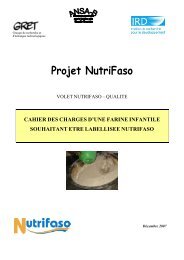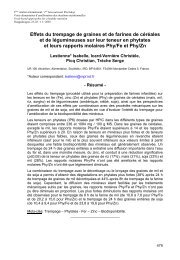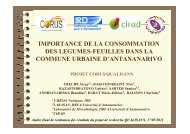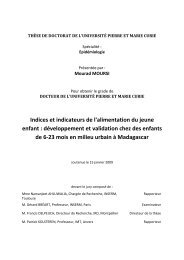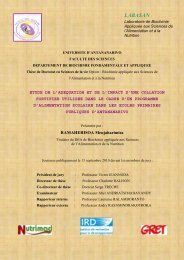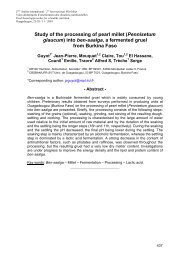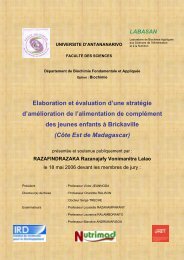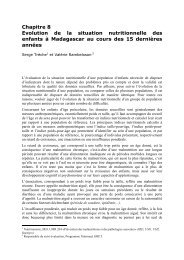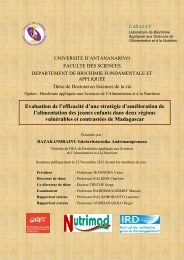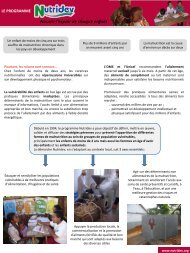THESE UNIQUE El Hassane Kéhien-Piho TOU - Nutridev
THESE UNIQUE El Hassane Kéhien-Piho TOU - Nutridev
THESE UNIQUE El Hassane Kéhien-Piho TOU - Nutridev
You also want an ePaper? Increase the reach of your titles
YUMPU automatically turns print PDFs into web optimized ePapers that Google loves.
E.H. Tou et al. / International Journal of Food Microbiology 106 (2006) 52–60 53<br />
representative number of traditional production units to take<br />
into account variability induced by field conditions. The main<br />
problems involved in obtaining information that describes<br />
traditional processes in a reliable way are surveys, sampling<br />
and processing of numerous samples which are labor intensive,<br />
time consuming and expensive. In addition, there are not<br />
always enough traditional production units (TPUs) in a given<br />
area, and it is not easy to access them, as they are often cottage<br />
or family (micro)-enterprises.<br />
In Ouagadougou (Burkina Faso), a large number of TPUs<br />
for millet-based fermented gruels exist. These gruels are called<br />
ben-saalga and ben-kida in mooré (language of the main<br />
ethnic group in Burkina Faso) or koko in dioula. They are sold<br />
early in the morning in a ready-to-eat form in front of the<br />
producer’s home or on the street and are frequently eaten by the<br />
population for breakfast. A preliminary survey established that<br />
49% of households in Ouagadougou eat these fermented<br />
gruels. In the households considered as regular consumers,<br />
75% of children less than 5 years old are regularly fed with<br />
these gruels (Cerefer, 2003).<br />
The purpose of the investigation presented in this paper was<br />
to study the processing of pearl millet into ben-saalga in a<br />
wide range of TPUs in Ouagadougou, with the aim of<br />
providing a rational basis for the improvement of processing<br />
techniques and thus the nutritional quality of ben-saalga for its<br />
use as complementary food for infants and young children.<br />
2. Materials and methods<br />
2.1. Raw material and aromatic ingredients<br />
The raw material used in the preparation of ben-saalga and<br />
ben-kida in the TPUs was pearl millet (Pennisetum glaucum)<br />
together with aromatic ingredients: ginger, mint, pepper and<br />
black pepper. These ingredients were purchased by the<br />
producers in the local market.<br />
2.2. Observations and sampling in production units<br />
A total of 24 TPUs of fermented gruel were randomly<br />
selected from a list of 93 TPUs identified during a previous<br />
survey carried out in the town of Ouagadougou (Cerefer,<br />
2003).<br />
To describe the different processing steps and to characterize<br />
the variability of the resulting product, the following<br />
measurements were performed in each TPU: duration of each<br />
step; weighing of the raw material used (grains, other<br />
ingredients, water), intermediary and final products and wastes;<br />
titratable acidity of unfermented wet flour and fermented paste;<br />
pH and consistency of gruels. Products of the different stages<br />
were sampled and freeze-dried for further analyses.<br />
2.3. Titratable acidity<br />
Samples were prepared by mixing either 80 g of unfermented<br />
wet flour or 10 g of decanted paste with 200 ml<br />
distilled water. Titratable acidity, reported as lactic acid<br />
equivalent, was determined by titration of 40 ml of these<br />
solutions against 0.1 M NaOH using 1% phenolphthalein as<br />
indicator.<br />
2.4. Changes in pH<br />
During the soaking and settling steps in the TPUs and in the<br />
pilot scale experiments (PSE), changes in pH were continuously<br />
measured on-line using a pH-meter register (WTW 340i,<br />
Fisher Bioblock Scientific, Illkirch, France). Recorded data<br />
were thereafter transferred into an Excel file.<br />
2.5. Fermentation kinetics<br />
As study of fermentation kinetics in TPUs was logistically<br />
difficult, the traditional process was replicated at the University<br />
of Ouagadougou in pilot scale experiments that reproduced the<br />
field conditions identified in the survey. Experiments were<br />
performed at ambient temperature, using identical ingredients<br />
and recipients to those used by the producers. Grains for the<br />
soaking experiments and flour for the settling experiments<br />
were purchased from different producers. For soaking, five<br />
independent pilot scale experiments were performed. For<br />
settling, considered to be the most important step, three series<br />
of independent triplicate experiments were performed (a total<br />
of nine experiments).<br />
2.6. Enumeration of aerobic mesophilic bacteria, lactic acid<br />
bacteria, amylolytic lactic acid bacteria and yeast<br />
Plate counts of aerobic mesophilic bacteria, lactic acid<br />
bacteria (LAB), amylolytic lactic acid bacteria (ALAB) and<br />
yeast were determined on the following media: Plate Count<br />
Agar (PCA, Difco), de Man, Rogosa and Sharp (MRS, Difco),<br />
modified MRS (without tween 80, glucose was replaced by<br />
soluble starch at 20 g/l) and Yeast Glucose Chloramphenicol<br />
(YGC, Oxoïd), respectively. Samples were unfermented wet<br />
flour and fermented pastes taken from 12 TPUs. MRS and<br />
modified MRS plates were incubated at 30 -C for 48 h, PCA<br />
plates at 30 -C for 48 h and YGC plates at 30 -C for 3 days.<br />
2.7. Analytical methods<br />
Lactic acid, acetate and ethanol in supernatants from the<br />
soaking and settling steps were analyzed as previously<br />
described (Calderon et al., 2001) by HPLC using an Aminex<br />
HPX-87H column (Biorad, Yvry-sur-Seine, France) connected<br />
to a refractive index detector (Waters 2410, France).<br />
Mono- and disaccharides were analyzed by high-performance<br />
ion chromatography (HPIC) using an anion exchange<br />
chromatograph (Dionex S.A., Jouy en Josas, France) with a<br />
Carbopac PA1 column (Dionex S.A., Jouy en Josas, France)<br />
connected to an amperometric detector (Dionex Model ED 40).<br />
Phytate (IP6) content was determined on freeze-dried<br />
samples by HPIC using an Omnipac Pax-100 anion-exchange<br />
column (Dionex S.A., Jouy en Josas, France) (Talamond et al.,<br />
1998).



